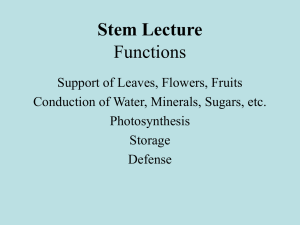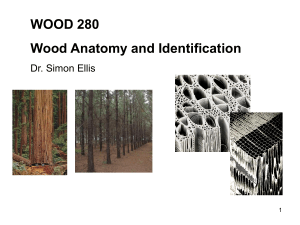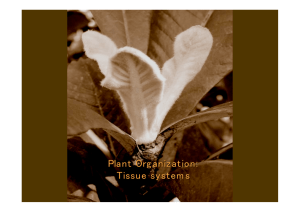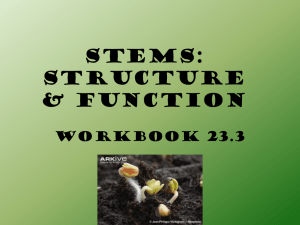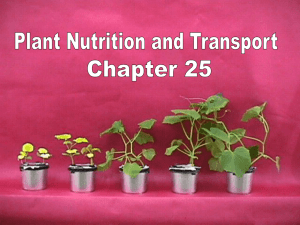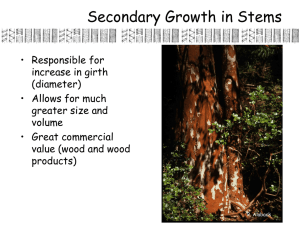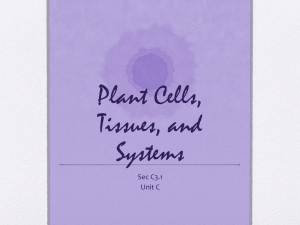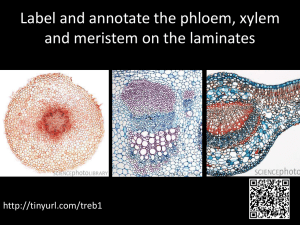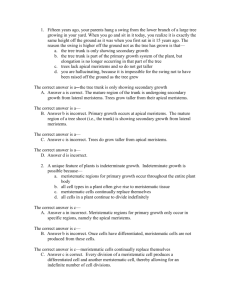Document
advertisement
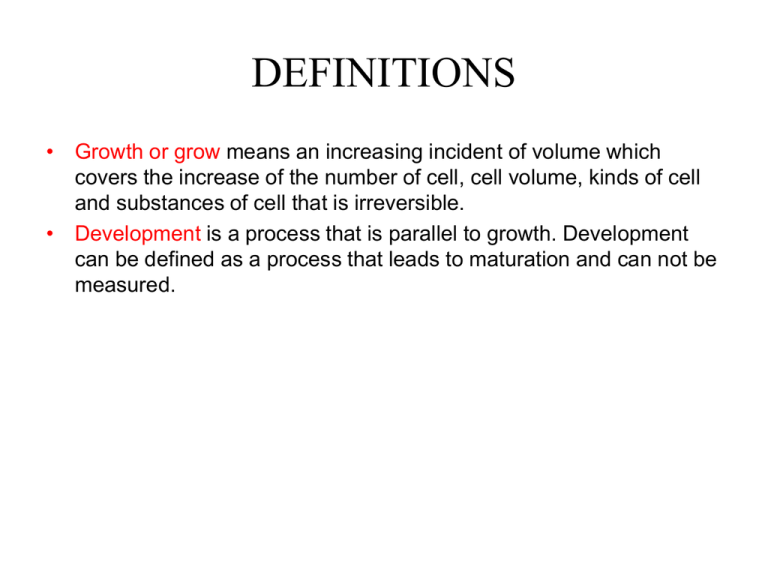
DEFINITIONS • Growth or grow means an increasing incident of volume which covers the increase of the number of cell, cell volume, kinds of cell and substances of cell that is irreversible. • Development is a process that is parallel to growth. Development can be defined as a process that leads to maturation and can not be measured. MERISTEM TISSUES OF PLANT Anatomy of tree (Campbell, 1997). 1. Growing point : It happen in root and stem ends and make plants higher and loonger. It is called primary growth. There are 2 theories of growing point:: a. Histogen Theory stated by Hanstein. Consist of: - Dermatogen, - Periblem, - Plerom, b. Tunika Korpus Theory stated by Schmidt. Consist of: - Tunika, - Korpus, 2. Vessel Cambium (between xilem dan floem). Makes plants grow wider, it is called secondary growth. 3. Sponge Cambium (felogen) the growth goes outside to form sponge cells (felem) instead of broken epidermis. This is to cover surface and go inside making living feloderm of cell. There is a cleft among sponge cells that is as a place where the air comes in and it is called cell lenti. 4. Perisikel (perikambium) ia a tissue which functions to form branches of root and stem. 5. Stem Parenkim INFLUENCIAL FACTOR OF GROWTH Table. Nutrition needed by plants 1. Nutrition fertilizer influence plant growth (see picture). E.g, nutrition needed by plants are shown in the table. Picture 1. The differences of growth in corn. Plant has enough nitrogen (left). Deficiency of nitrogen elements (right) (Campbell, 2006). Picture 2. Leaf condition (a) normal leaf, (b) nitrogen deficiency, (c) phosphate deficiency, (d) potasium deficiency (Campbell, 2006). 1. Gen is the carrier factors of nature that are owned by all creatures, both plants and animals. 2. Environment around plants: 1. Temperature: plants can live well in optimum temperature 2. Light, at green leaved plants, the light is regnited for photosynthesis. 3. Water o r moisture is needed by plants for the growth. 3. Growing substance (hormone) can influence the growth of certain organs. KINDS OF GROWING SUBSTANCES 1. Auksin is indl asetat cmpound and its combination, found in enlonging plant ends. Functins of auksin: 1. Stimulating cell enlonging 2. Stimulating growing plants 3. Stimulating the forming of fruits without pollination called partenokarpi. 4. Bending stem 5. Stimulating lateral & fibrous root 6. Stimulating the split of vessel cambium 7. Making differential cells xylem 8. Increasing the development of flower and fruits. 9. Apical domination (obstructing the growth of side shoof/ arnynt) Picture. (Campbell, 2006). 1. Giberelin, was found in giberella fujikuroi (a kind of parasitic moss in rice plant). Function of giberelin: 1. Stimulating cambium activities 2. Causing plants in bloom faster 3. Enlarging fruits 4. Influencing embryo growth 5. Obstructing seed forming 6. Stimulating the forming of pollen line and flowers. 7. Breaking seed dormant and side bud. Picture 8.25. The effects of giberelin wards fruit growth. (Campbell, 2006). lanjutan … 1. Sitokinin Sitokinin function to: Stimulate the spilt of cell faster Stimulate bud growing to the side Stimulate the widening of leaf Reduce apical domination Control the forming of flower and fruit Delay the falling of leaf, flower, and fruits by increasing food supply to those organs. Picture. The effect of sitokinin toward leaf wideming. 1. Kalin functions to stimulate the growth of certain organs. Based on organs affected, it is devided into: 1. Kaulokalin, functions to stimulate stem growth 2. Rhizokalin, functions to stimulate root growth 3. Fitokalin, functions to stimulate leaf growth 4. Anthokalin, functions to stimulate flower growth 5. Traumalin acid, functions to stimulate “kalus” growth of dicotil stem injured. 6. Absisat acid, functions to obstruct the growth in bad conditions so that the plant is in dormant condition. The Vascular Cambium Definitions Cell division related to cambial activity Axial: Along the axis of the organ, or organism Radial: At right angles to the axis, i.e., along a radius Tangential: At right angles to a radius. Ray Initial: Meristematic cambial cell. Forms a file of cells (one or more wide) that is composed of parenchyma. Orientated ALONG a RADIUS. Contributes to the RADIAL transport system Fusiform Initial: Meristematic cambial cell. Forms new secondary xylem and secondary phloem and associated cells. Contributes to the AXIAL transport system. Notes THE VASCULAR CAMBIUM The vascular cambium is unlike the primary meristems (root and shoot apex) of the plant, in that it produces new cells and tissues which add to the axial system (i.e. the conducting system) as well as to the radial system (i.e. the lateral transport pathway). In contrast, apical meristems of the shoot and root add only to the axial system. The cells of the vascular cambium do not fit the regular concept of meristematic cells (i.e. small, isodiametric shaped cells, with a dense cytoplasm and containing large nuclei). Cambial cells are usually highly vacuolate and occur in two forms, namely fusiform cells and ray cells. Fusiform cells are prism-shaped with a distinct wedge-shape at both ends. Ray cells are short and squat. Tangentially, both cell types may be wider than they appear in radial section or longitudinal view. The slides that follow will assist to orientate you with respect to the planes of cell division within the cambium. The two cell types (fusiform and ray cells) have unique functions. Fusiform cells usually only produce cells associated with the axial system -- that is, they produce either new elements of the xylem, or elements of the phloem. Fusiform cells thus add new cells to the AXIAL conducting system. Ray cells on the other hand, produce ONLY ray cells and thus add to the RADIAL system of the plant AXIAL Axial: Longitudinal translocation, xylem & phloem elements. Radial: Lateral translocation. Carbohydrate from phloem, to parenchymatic (living) tissue, water from xylem to living tissues as well. Fusiform vs. ray initials radius tangent Fusiform and ray cells form FILES of cells – each file contains a number of differentiating elements. Both can divide radially OR tangentially endarch TANGENTIAL face exarch TANGENTIAL face exarch TANGENTIAL face RADIAL face RADIAL face Development of secondary vascular tissues in stems During primary growth, the vascular bundles produce PRIMARY vascular tissue. These are the primary phloem (proto + meta) and primary xylem (proto and meta). The fascicular cambium separates the two tissues. Remember: a fascicle is a vascular bundle 1. Development commences within the fascicular cambium (between the primary phloem and primary xylem) First activity is in the vascular bundle 2. FCZ = fascicular cambial zone Secondary xylem Secondary phloem FC Secondary xylem and phloem are produced by the fascicular cambium (FC). 3 The interfascicular regions begins to differentiate and a cambium originates here. The interfascicular cambial area in herbaceous stems is not usually active, thus does not produce new phloem or xylem tissues PX MX 2X 2P 1P PPF CZ 3b 3a A widening band of secondary vascular tissue results from the cambium’s activity. CZ 4 The ring of secondary tissue is Complete. The interfascicular and fascicular cambia together form a vascular cambium Cambial activity in the root Phloem Protoxylem Metaxylem endodermis pericycle Typical Dicot Root, end of primary growth (cambial activity in Gymnospermous roots is very similar). Formation of the cambium. Stage 1. endodermis pericycle cambium appears between the metaxylem and the metaphloem Typical Dicot Root Formation of the cambium. Stage 2. endodermis pericycle Typical Dicot Root filling out 2X 2P Cambial cells differentiate more rapidly at the interface between the metaxylem and the metaphloem. secondary phloem is produced centrifugally (outwards) as is secondary xylem. In a centripetal (inward) direction. Outward pressure begins to be applied to the primary phloem strands. These strands are gradually forced outwards, to make way for the newly-added secondary vascular tissues. filling out E = endodermis P = pericycle 2X = secondary xylem 2P = secondary phloem P – pericycle E = endodermis 2X 2P P E 2. Primary phloem strands become crushed, loose functionality 1. Outward pressure caused by the addition of new cells continues – effectively ‘rounding out’ the ring of secondary vascular tissue 2X 2P P E 3. Primary phloem strands have lost their functionality Remnant of primary phloem strands – (located by orange arrows) become completely crushed, and are non-functional E 2P 2X E = endodermis P = pericycle 2X = secondary xylem 2P = secondary phloem P – pericycle E = endodermis P The root will retain its primary xylem, which will be visible and may be functional
